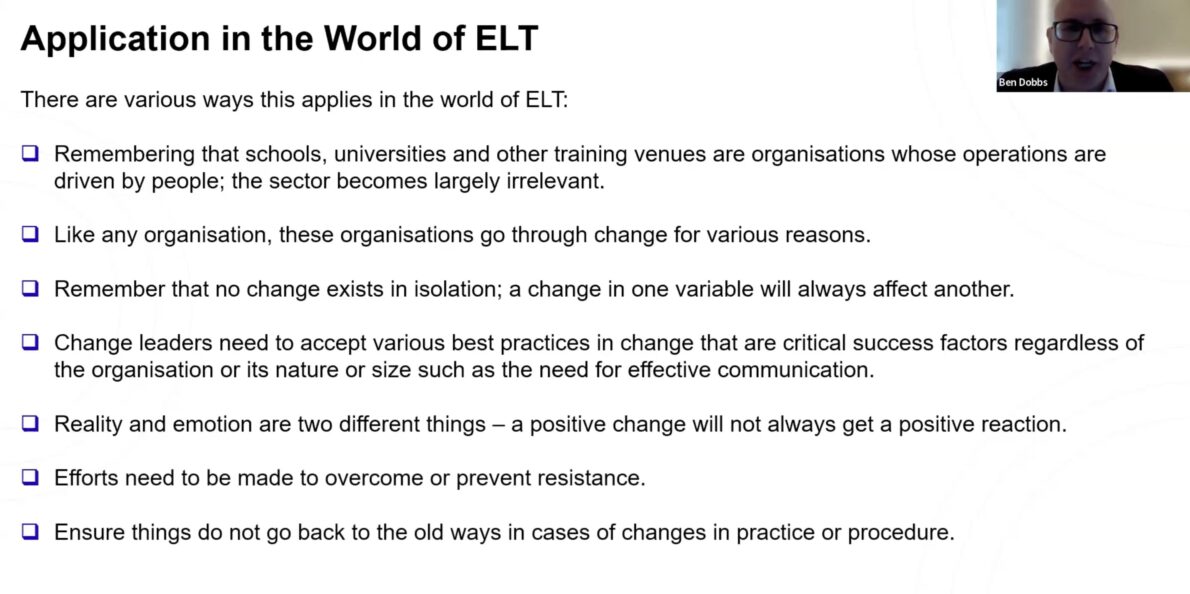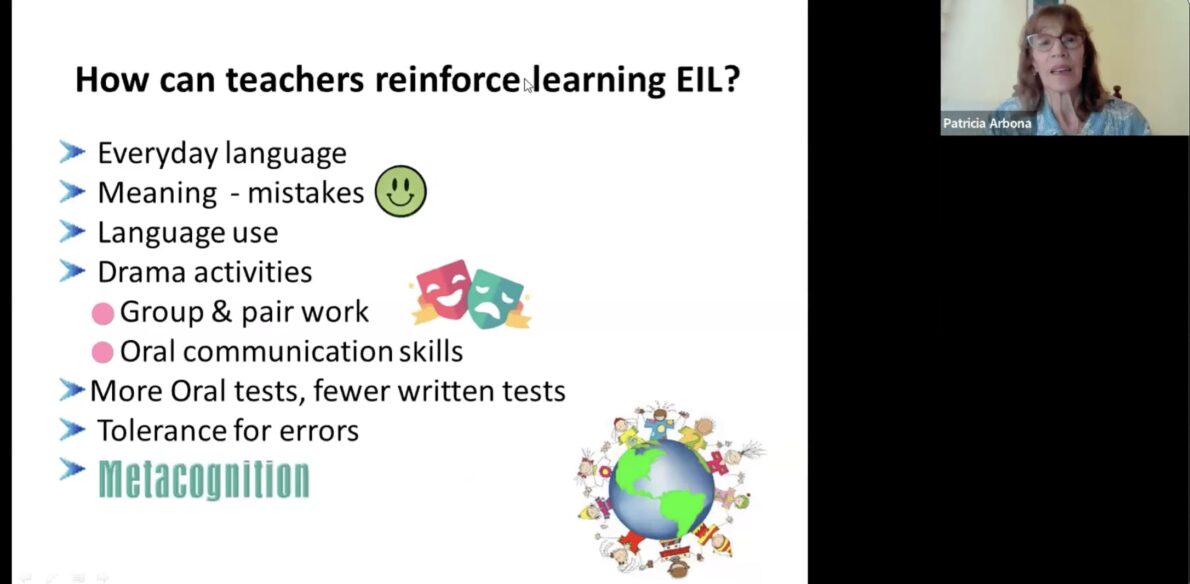Empowering English language teachers to embrace change as a catalyst for professional growth, the IATEFL’s Teacher Development Special Interest Group (TD SIG) chapter hosted its eighth web carnival, titled “Teacher Change,” on October 19th and 20th.
Offering fresh perspectives and practical tools to navigate the evolving landscape of English language instruction and career paths, the two-day virtual conference featured a diverse range of topics, including 21st-century teaching skills, teacherpreneurship, and innovative approaches to digital classroom transformation.
Interested in learning about tools you can use in your online English classroom? Read this next: 26 Best Digital Tools for Teaching English Online.
Fostering growth and connection in ELT
Through a series of plenary sessions and expert-led talks, the event also provided a platform for ELT professionals to share valuable insights, resources, and strategies, fostering a collaborative environment for educators to exchange ideas and connect with the TD SIG community.
As one of IATEFL’s 16 Special Interest Groups, TD SIG focuses on promoting professional development for the English language teachers in their community. The group also regularly hosts online and in-person conferences and provides avenues for their members to share their knowledge and reflections with the ELT community through their publications and blog.

Elizabeth Coleman, a member of the TD SIG Committee, shared that one of their goals for the conference was to show that teachers can grow and develop in many ways throughout their careers.
“We thought about how teachers go through various changes, from teaching beliefs to teaching approaches, going beyond English teaching and also developing diverse ways of engaging with professional development. So, we decided it would be interesting to explore how and why this happens and is documented,” Coleman shared. “We also wanted to showcase the different experiences of teachers and the unique challenges and approaches we have as educators in different environments.”
Coleman also noted that there was strong engagement from both attendees and presenters at the event.
“The quality of the sessions was high, and we were delighted to be able to host so many colleagues. The discussions in the rooms were great and our attendees seemed very engaged with the topics,” she added. “Our presenters also enjoyed delivering their sessions. It’s a wonderful opportunity for teachers to talk about their research, network, and find new connections.”
Take a deep dive into 5 strategies to get the most out of professional development.
Make transferable skills a part of every ESL lesson with the free
Guide to Teaching 21st-Century Skills in the ESL/EFL Classroom
downloadDriving teacher transformation and development
The series of sessions on teacher transformation began with a plenary talk by Change Management Specialist Ben Dobbs and was titled “What Drives Resistance to Change?”
Dobbs engaged the audience by asking about their views on change and resistance to it. He then defined “change” by outlining the six stages that individuals and organizations experience during the implementation of a change. He stressed that one of the main reasons members of an organization resist change is when the management rushes large transformations.
“One of the biggest mistakes people make with the six-step change is that managers often take a big leap rather than small steps. You can’t suddenly go from one way of doing things to another way of doing things immediately,” he pointed out.
After identifying the main factors behind resistance to change, Dobbs then shared how to address them, such as by communicating effectively and showing the benefits of change to organization members. Dobbs emphasized that like other organizations, schools and universities are people-driven and constantly evolving – a principle that applies directly to English language teaching.
“If you can bring about change in one organization, you bring about change in another,” Dobbs said, adding that change leaders should adopt best practices in change that are critical to success.

In another session titled “Teaching in the 21st Century,” teacher trainer and drama educator Patricia Arbona explored strategies that English teachers can use to help students develop crucial skills for thriving in today’s globalized world.
Focusing on innovative approaches to teaching English as an international language, Arbona highlighted the role of English as a lingua franca, which has reshaped English language teaching in recent decades.
“English has become a tool for global communication and an international language because it’s widely used by non-native speakers with a variety of accents,” she explained, highlighting its role as a bridge for multicultural communication.
In teaching English as an international language, Arbona encouraged educators to implement strategies that further enhance students’ communication skills. This includes fostering listening abilities across a range of accents, using authentic materials, and incorporating activities that promote transferable skills, such as collaboration in groups or pairs.
While traditional methods still have their place, Arbona emphasized the importance of developing new skills and strategies to stay current with modern methodologies and adapt teaching practices to emphasize real-world language use.
“I know that having to change your way of teaching, which has been the same for ages, is difficult,” she noted. “However, you need to change your attitude. Everything is changing, and teaching English has changed too because the language has changed and evolved.”

Bridge participation: Guiding English teachers toward teacherpreneurship
In addition to sponsoring this year’s web carnival, Bridge took part in the online event by highlighting how teachers can chart their own journey toward becoming teacherpreneurs.
In her presentation, “From Teacher to Teacherpreneur: Embracing the Entrepreneurial Mindset,” Bridge International Program Advisor Krzl Nuñes first encouraged teachers to embrace an entrepreneurial mindset by highlighting its benefits.
“By taking the independent path as an English teacher, you’ll have more flexibility and freedom. For example, you can choose when and where you want to teach, and you can also decide the types of students you want to work with,“ Nuñes asserted during her presentation.

In her talk, Nuñes also shared tips on how aspiring independent English teachers can successfully establish their businesses. For this, she first elaborated on how teacherpreneurs can choose a teaching niche, which she emphasized as a key factor in attracting more potential students, standing out from other teachers, and improving marketing efforts.
She also provided insights on how independent English teachers can structure their product offerings and create their Unique Selling Proposition (USP) to ensure their ventures stand out and appeal to their target learners.
As Nuñes ended her talk, she encouraged attendees to share their main drivers for pursuing an independent English teaching path. She shared hers: “In my case, I wanted to be able to do what I love, let my personality shine through my lessons, and pass on my values to learners.”
Whether it’s enhancing language instruction or redefining career paths, professional development is a vital component of an English language teacher’s growth. This year, through the web carnival, TD SIG provided more support for English teachers to embrace transformation in their careers. By learning about the latest research, best practices, and technological innovations in the field at this year’s conference, educators can start to seize more opportunities and be better equipped to adapt to changes in the ever-changing field of English language teaching.











